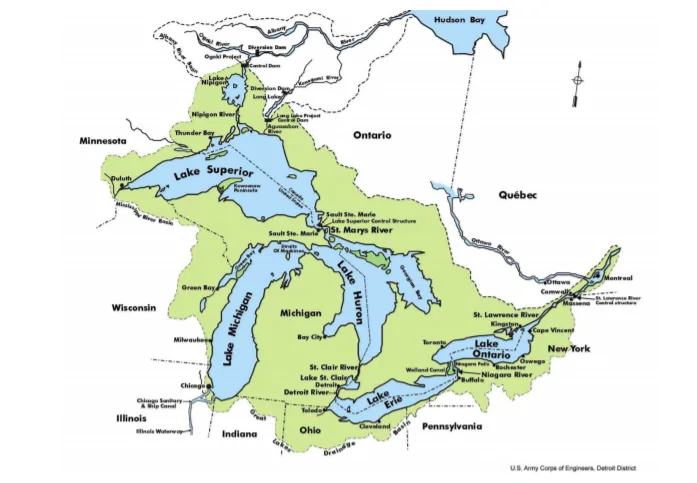Humans have historically contributed to the destruction of numerous natural resources – the impacts of climate change included. The Great Lakes and the surrounding ecosystem have experienced a changing climate, in part, as a result of the anthropogenic increase in greenhouse gas emissions in the atmosphere. The climate is projected to continue to change with warmer temperatures, higher levels of precipitation, and a higher frequency and intensity of extreme events. All of these changes pose a threat to the Great Lakes watershed.
The Great Lakes are one of the largest sources of freshwater on earth, containing 21 percent of the world’s surface freshwater. Spanning over 1,200 kilometers, the Great Lakes border the province of Ontario and the states of Illinois, Indiana, Michigan, Minnesota, New York, Ohio, Pennsylvania, and Wisconsin. There are 35 million people living in the Great Lakes watershed and the lakes provide drinking water for over 40 million people. Agricultural, industrial, and municipal activities are also dependent on water from the Great Lakes. The Great Lakes watershed consists of a vast drainage basin connecting to the ecosystems surrounding the St. Lawrence River, the Detroit River, Lake Nipigon, and many other bodies of water.
The Great Lakes are a critical source of potable water, however, billions of dollars in shipping, trade, manufacturing, agriculture, mining, energy, fishing, forestry, and tourism are also dependent on them. These activities have greatly contributed to the deterioration of the surrounding environment. The heavy human use of natural resources has resulted in polluted air, water, and soil, as well as habitat loss, fragmentation and influxes of invasive species. Recently, the most significant human-made threat to the Great Lakes watershed is climate change. The climatic changes can introduce further stresses on the ecosystem thus altering the region’s natural environment.
Climate Change in the Great Lakes Watershed
In 2019, Canada’s Changing Climate Report (CCCR) revealed that the average temperature in Canada doubled the global average. In Ontario alone, the average annual temperature has increased by 1.3°C as compared to pre-industrial levels (1948). Projections suggest that the temperature in Ontario is likely to increase by 6.3°C by the end of the century relative to 1985-2005.
According to the CCCR 2019, observed precipitation changes in Canada have also increased. Levels have increased by approximately 20 percent and they are projected to increase an additional 24 percent by the end of the century. However, precipitation projections include pronounced unpredictability and volatility, likely resulting in both periods of flood and drought; specifically, summer months are expected to experience extremely low levels of precipitation.
The CCCR 2019 also confirms that there has been an increase in frequency and severity of extreme weather events across the country. Extreme event attribution is a relatively new climate science that has emerged to determine whether extreme events can be attributed to climate change since not all extreme weather events are the direct result of climate change. The United States regions that border Canada experience similar trends reported by the Canadian government.
In Canada, the Canadian Hydrographic Service (CHS) monitors the Great Lakes and in the United States, the National Oceanic and Atmospheric Administration Great Lakes Environmental Research Laboratory (NOAA-GLERL) monitors the Great Lakes and the climate in the region. These organizations, often collaborating, have found that the average annual water and air temperature of the Great Lakes have increased in the last century.
The average annual air temperature in the Great Lakes region in both the US and Canada has increased by nearly 0.9°C relative to 1901-1960. This increase is much higher compared to the rest of the United States with an average increase of around 0.67°C. Temperatures are predicted to increase in the Great Lakes region; by the end of the century, the temperature could increase up to 7°C. The water temperatures will likely experience a similar increase of up to 6.7°C by the end of the century, resulting in a 42 to 90-day increase in ice-free days.
Like the effect of the ocean on the climate, smaller bodies of water can create a similar effect on the climate on a smaller scale. The Great Lakes heat and cool more slowly than land and create more moderate temperatures than places at the same latitude in Canada and the United States that are not along the coast or near similarly large bodies of water.
This year, the ice coverage on the Great Lakes reached a near-record low. The long-term average for ice coverage on the Great Lakes is 55 percent. This winter, only 22 percent of the lakes’ surface was covered in ice. Some lakes only had faint traces of ice near the shoreline or only froze for a short time, while others didn’t freeze at all. Based on historical records, scientists believe that this winter provides a glimpse of future trends.
Annual average precipitation levels in the Great Lakes region have increased by 10 percent and are projected to increase an additional 20 percent by the end of the century. Lake effect snow – as a result of cold dry air passing over warm bodies of water – occurs when the lake doesn’t freeze. As ice coverage and frost days (below 0°C) decrease, precipitation levels are projected to notably increase in the Great Lakes region.
The wind is a key component of the Great Lakes ecosystems as it supports lake currents, shifting ice coverage, and the thermal regime. An increase in the frequency, speed, and duration of wind can impact the ecosystem and create windstorms. It is projected that wind speeds will increase in the Great Lakes region resulting in a higher frequency and intensity of extreme events such as windstorms and tornados.
Climate change will also have an impact on water levels. In 2019, the Great Lakes water levels reached record-breaking heights, approximately one meter above the recorded historical average. The last record-breaking heights were recorded in 1986. In 2019, the U.S. Army Corps of Engineers announced that water levels will continue to rise in 2020. Some regions are projected to experience water levels up to 30 cm higher than they were in 2019.
Average Monthly Water Level (in meters): Projections for 2020

The Impact of Climate Change on the Great Lakes
The impact of Climate Change on the Great Lakes and surrounding ecosystems is remarkably ecological, physical, social, and economic. The climate has a profound influence on biodiversity; therefore, climate change is predicted to introduce significant impacts on the Great Lakes ecosystems. The changing climate initiates the redistribution of flora and fauna which can alter an ecosystem in varying degrees. There are already well-documented cases of invasion by new non-native species and replacement of previously abundant species. Surveys of sport and baitfish populations reveal that the range of fish has shifted towards the north at a rate of 13 to 17.5 kilometers each decade for the last 30 years.
In more severe cases, there is the threat of the emergence and proliferation of pests and diseases and even the extinction of native species. Agricultural, stormwater, and wastewater runoff can cause algal blooms in the Great Lakes and extended periods of heat and drought further foster algae blooms. Evidence of extensive blue-green algal blooms caused by climatic events and considered harmful have been found in the basin of Lake Erie.

The physical impacts of climate change are most noticeable from flooding and extreme events such as windstorms and tornados. Rising water levels erode shorelines and swallow natural spaces. Erosion and flooding pose a threat to the surrounding built infrastructure such as park assets, bridges, and roads. Communities located in the Great Lakes region may experience more severe windstorms or tornados as a result of climate change, causing damage to both the natural and built environment.
Public health and safety depend on the stability and predictability of the ecosystem in the Great
Lakes watershed. The quality of water is threatened by anthropogenic climate change as a result of blue-green algae blooms, soil erosion, and agricultural, stormwater, and wastewater runoff. These phenomena put undue stress on regional water filtering and treatment systems. The safety of the public is threatened by the physical impacts of flooding such as flooding and erosion. In some cases, homeowners located near the lakeshore are already at risk of losing their homes.
As a result of the ecological, physical, and social impacts listed above, regional economies may be impacted by climate change. The Great Lakes support tourism, fisheries, recreation, water distribution, commerce, and industrial sectors of the economy. Fisheries and tourism alone represent an estimated 7 billion and 16 billion USD respectively.
The social, economic, and physical well-being of over 35 million people depends on the preservation of the Great Lakes watershed. It is in the best interest of local communities to document the risks associated with climate change and make meaningful efforts to mitigate the impacts.
ERIN ORR, MA completed her master’s degree with Western University in Political Science, specializing in Canadian Policy and she is completing a certificate in Climate Change Policy and Practice from University of Toronto’s School of Continuing Studies.



